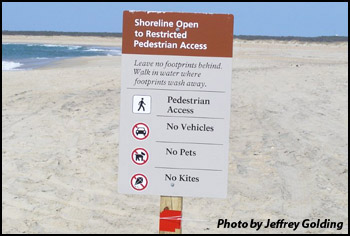Some of the Park Service?s new signage on the seashore has caused quite a stir this week with coverage in print, online, and broadcast media and plenty of discussion in the social media and blogs.
The signs have been erected recently to inform the public about the new rules under the Park Service?s off-road vehicle plan and final rule that became effective Feb. 15.
The signs in question have been placed in pedestrian-only areas, such as in the Hook west of Cape Point, where the accompanying photo was taken.
They are in the pedestrian-only areas that have pre-nesting closures that were put in place last week.
In those areas, pedestrian access is allowed along the shoreline until shorebird breeding activity is observed.
However, some folks think the Park Service has taken its new rules just a bit too far.
?Leave no footprints behind,? the signs advise. ?Walk in the water where footprints wash away.?

In other words, stay in the ocean if you want to take a walk.
Jim Keene, a director of the North Carolina Beach Buggy Association, shot off an e-mail last weekend to seashore superintendent Mike Murray.
He wrote:
?Please tell me that these signs were put up without your prior approval. I cannot believe that these signs were conceived of and produced as a product of rational thinking.
I am convinced that this signage closes the ?Pedestrian Only? areas to families with small children who must walk on the moist sand but out of the wave action and to all persons with walking handicaps. If this is not the case, please post some type of explanation that is understandable to the visiting public.
?What has happened to the NPS mantra of “Take only pictures and leave only footprints??
Murray responded in an e-mail to Keene:
?The ORV management plan allows for pedestrian shoreline access, but no pets, below the high tide line in front of (i.e., seaward of) pre-nesting areas until breeding activity is observed, then standard buffers for breeding activity will apply. The signs are based on Leave No Trace principles and used only adjacent to pre-nesting areas (i.e., shoreline that would typically have been closed to all access under the Consent Decree).
?There are many, many miles of shoreline open that are not affected by these restrictions, which are specifically limited to pre-nesting areas.?
The discussion has continued all week on the blogs and social media, and today U.S. Rep. Walter Jones, R-N.C., jumped on the issue in a letter to Murray.
In the letter, Jones points out that ?the signs falsely convey a level of restricted pedestrian access that goes beyond park laws and regulations.? And he asks Murray to replace the signs.
The full text of Jones? letter to Superintendent Murray:
?I am writing to convey my concern with new signs the National Park Service (NPS) has erected in several locations along the beach in Cape Hatteras National Seashore Recreational Area. I have attached a photograph of one of the signs for your review.
?The signs falsely convey a level of restricted pedestrian access that goes beyond park laws and regulations. They read: ?Shoreline Open to Restricted Pedestrian Access: Leave no footprints behind. Walk in water where footprints wash away.? However, the recently enacted final rule explicitly allows ?pedestrian shoreline access along ocean and inlet shorelines below the high-tide line . . . in front of pre-nesting areas until breeding activity is observed.?
?Clearly, these signs do not reflect the level of accessibility permitted in the rule. The rule?s allowance for visitors to walk below the high tide line does not mean that visitors can only walk in the ocean.
?The final rule is already hurting seashore visitors and nearby residents and businesses enough. They should not have to deal with additional restrictions not included in the rule. I urge you to promptly remove these signs and replace them with new signs that accurately convey the level of visitor accessibility spelled out in the final rule. If I can be of any assistance in securing this change, please do not hesitate to let me know.
?Thank you for (your) service and your consideration of this important matter. I look forward to hearing from you soon.?
Many of us find all of the signs that sprout along the seashore in the spring when shorebird nesting season begins offensive ? the visual pollution of one of the most beautiful natural areas anywhere.
They certainly are visual pollution along Highway 12, especially between Avon and Buxton and just east of Hatteras village where the road is lined with sign and sign connected by the string ?fencing.?
I guess this is just going to part of life with the new rules, but it?s a shame it has come to this.
The particular sign that has caused the furor in the Hook near Cape Point is no longer an issue.
Seashore biologists observed piping plover and American oystercatcher breeding activity in the areas earlier this week.
Now the area is closed to pedestrians, as well as vehicles.



